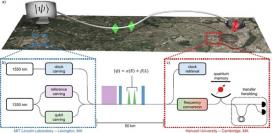Boston-Area Testbed Demonstrates Quantum Networking Across Three Nodes
A three-node network in the Boston area is testing quantum repeaters and other technology developed by researchers at the Center for Quantum Networks (CQN), an NSF-funded Engineering Research Center (ERC) based at the University of Arizona.
The demonstration advances research toward the central goal of CQN, which is to develop an error-corrected quantum network with connectivity rate of 1 megaqubit per second over metropolitan-scale distances.
Multiple technologies developed at the Center are integrated into an actual distribution of qubits, or quantum data packets, in a three-node topology. Harvard (with its quantum-memory-based node) is in the middle, and MIT and MIT Lincoln Lab (MIT-LL) are connected to Harvard by optical fiber. The first demonstration is that of an asynchronous Bell Basis measurement to do MDI-QKD at rates surpassing the photon-loss limited rate, followed by an experiment to deliver entanglement among remote memories over the Boston-area testbed developed by CQN.
A quantum state is prepared at MIT-LL, and the resulting signal consists of several pulses shaped from continuous-wave lasers. A 1550nm laser provides a reference clock for synchronization, while a 1350nm laser encodes a qubit in “early-late” time-bin encoding interlaced with a reference pulse for link stabilization. The receiver synchronizes operations using the clock pulse, performs quantum frequency conversion from the telecom band to the SiV resonant frequency, and interfaces the incident quantum state with the memory.



